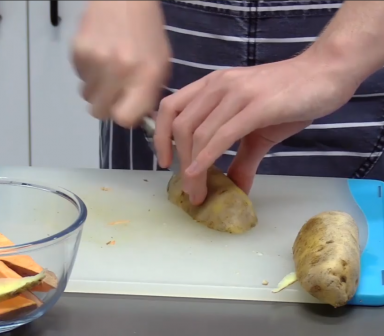There are plenty of techniques and pieces of equipment that can help blind and partially sighted people to cook safely. Jac Clougherty, one of the centre officers at Sight Scotland Veterans’s Hawkhead Centre in Paisley, works closely with veterans with sight loss in the centre’s skills kitchen.
Here are her top tips:
Food preparation
· Ensure crockery, utensils, food etc., are always kept in the same places. Consistency can help you to find what you are looking for more easily.
· Be organised – have your ingredients close at hand.
· Make use of task lamps and day light lighting, and project direct lighting onto your task. Down lighting on kitchen units can also make good lighting for shining lighting worktops.
· Have a bowl nearby for peelings to reduce clutter on work surface.
· Non-slip mats helps to stabilise bowls. Bowls with non-slip bottoms and non-slip chopping boards with prongs are available. Chopping boards with funnels can make it easier to direct food into pans and bowls.
· Use mugs to hold utensils – this can help you to locate them more easily whilst preparing food.
· Consider using recipes that use cups, spoons etc. for measuring, as this can make measuring ingredients easier
· Sharp knives are safer than blunt knifes for cutting/slicing.
· Food processors with attachments for slicing and chopping are useful for prepping fruit and vegetables.
Colour contrast
Colour and colour contrast can be a huge help in navigating kitchen tasks.
· Use a different coloured chopping board. For example, a red chopping board may help potatoes stand out. A white chopping board may be more helpful for slicing carrots. A dark chopping board on a light surface can provide better contrast.
· If pouring liquid, it's easier to use colour-contrasting mugs, like a dark coloured mug for milk.
· A coloured bowl may be easier when mixing flour.
· Contrasting edging on work surfaces may help to identify the edge of the work surface. Matt work surfaces may also reduce glare.
Boiling and pouring water
· Talking jugs provide audio measurements.
· One-cup kettles automatically dispense a mug’s worth of boiling water straight into your mug.
· Heat resistant gloves protect your hands from heat and can provide good grip.
· A water boil alert will rattle in the pot when water reaches boiling point.
· An anti-slip tray placed under a mug can be useful when making a hot drink – if the liquid spills it can be easily cleaned from the tray rather than spreading over a work surface.
Setting the oven or microwave safely
· Bump ons are colourful raised stickers that can help you locate settings on microwaves and cookers.
· A Tacti-Mark Pen can be used to create tactile marks for dials and buttons.
· Talking microwaves are available.
Storage tips
· Write your own labels in large print with a bold pen to mark food items and dates.
· When you want to check dates or ingredients information, try using apps. TapTapSee is a smartphone app which allows you to take a picture of an object, and then identifies what it is. Be My Eyes connects blind and partially sighted people with sighted helpers from around the world via a live video connection.
· A Penfriend is an audio labeller that allows you to record your own voice onto labels. You can laminate the labels or place clear tape over them when using on frozen items. Talking tin lids can also help keep track of ingredients and dates.
· Try placing elastic bands or tactile bands around tinned food to help identify different items or contents, for example one band for tinned peas, two bands for tinned beans.
· Transfer dry ingredients into rigid, labelled plastic or glass containers. This can makes measuring, identification and storing easier.
Talking devices
Some of the most useful talking kitchen devices to aid blind and partially sighted cooks include:
· Talking microwave
· Talking scales with an easy-to-see jug
· Talking measuring jug
· Penfriend for labelling foodstuff
· Talking timers
· Talking food thermometers
· Talking tins.

More on Sight Scotland Veterans' skills kitchens
At Sight Scotland Veterans’s Hawkhead Centre in Paisley and Linburn Centre in West Lothian, many veterans with sight loss have developed sight loss in later life.
Cookery sessions in the centres’ skills kitchens help these blind and partially sighted veterans adapt their cookery skills, enabling them to rustle up tasty meals and treats and even learn a few new kitchen tricks along the way.
Jac explains: “One of our veterans at the Hawkhead Centre requested to make mince and tatties, as this was a dish he had really enjoyed but had not made it himself for years due to a lack of confidence in the kitchen following his sight loss.
“After coming into the skills kitchen and being supported to make this dish using some of these tips and techniques, he is now confidently and independently making mince and tatties in his own home.
“Another of our veterans was fairly new to the Hawkhead Centre when he came into the skills kitchen. Using these tips he made a chicken curry for the first time ever for both himself and his wife. He was so pleased with this achievement that he now regularly comes to the skills kitchen, where he makes dishes to take home for their dinner.”
Find out more about how Sight Scotland Veterans helps veterans with sight loss here.